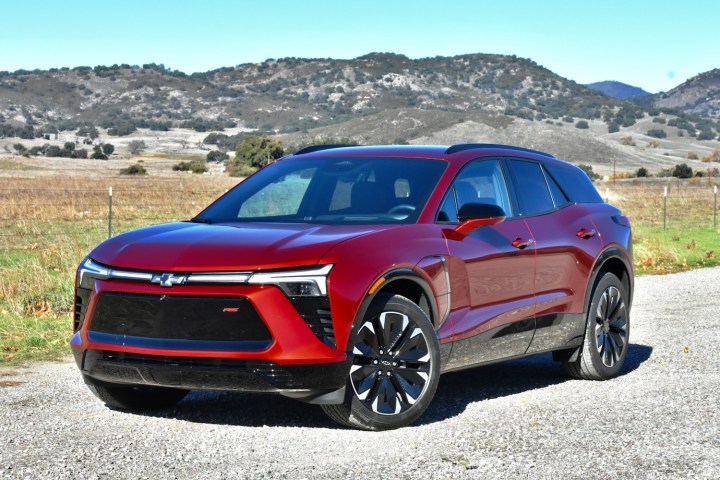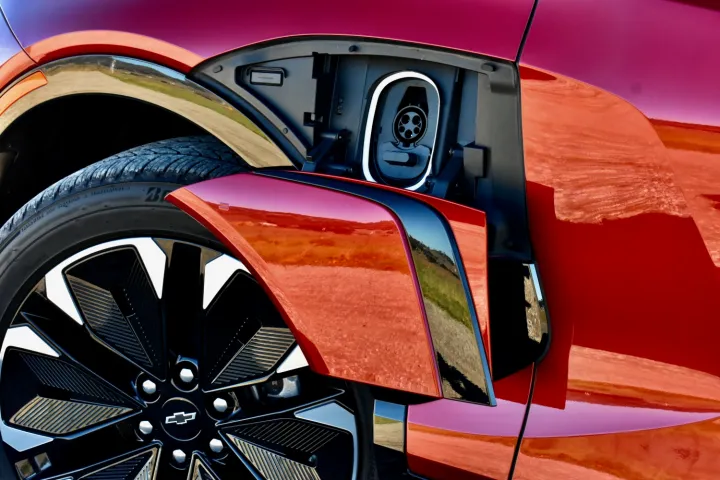
They say good things come to those who wait. General Motors is hoping customers will take that maxim to heart.
The 2024 Chevrolet Blazer EV, an electric crossover SUV sharing the name of a similarly sized gasoline model, but nothing else, was first shown in the summer of 2022 and quietly entered production a few months ago. But few cars have made it to customers due to production issues that have plagued not just the Blazer, but all of GM’s new EVs, which use a shared component set branded Ultium that’s proving tricky to scale up.
Chevy is already late to the game, as rival crossovers like the Ford Mustang Mach-E and Kia EV6 have been in showrooms for some time. The Blazer EV will at least be available in a wide array of configurations, eventually, but for now we’re checking out the Blazer EV RS — the first version to go into production. While Chevy has said the Blazer EV will have a base price as low as $44,995, the versions we drove were in the $60,000 range.
Design and interior

The Blazer name originated with boxy off-roaders, but Chevy used the modern gasoline Blazer — a mall crawler with no off-road pretensions — as a design starting point for the Blazer EV. The electric model takes the current gasoline Blazer’s sleek styling elements and stretches them over a dedicated EV platform. While the EV looks longer and lower than the gasoline Blazer — generally a good thing in automotive styling — it has somewhat odd proportions. And while distinctive, some design touches like the curvaceous fenders and angry-looking front fascia might not be to everyone’s liking.
The Blazer EV looks a bit more SUV-like than the rival Ford Mustang Mach-E and Kia EV6 — and that might be its greatest design asset. The Ford and Kia’s SUV-ness is largely down to marketing, but the Blazer EV truly has the SUV look. It’s also much longer and wider than the Ford and Kia, giving it more visual presence.
With the exterior and interior, Chevy took a different design approach compared to rivals.
The Chevy also feels like a true SUV from behind the wheel, although not necessarily in a good way. It feels massive, in part because the driver is seated very far back behind a deep dashboard and below high sills. The larger footprint also doesn’t really translate to more interior space. Headroom and legroom in both rows are pretty close to that of the Mach-E and EV6. With its rear seats in place, the Chevy has slightly more cargo space than the Kia, but less than the Ford. The two American EVs have about the same amount of cargo space with their rear seats folded, but the Ford also has a substantial frunk.
Like the exterior, the interior design takes a different approach compared to rivals. The Mach-E and EV6 interiors offer pleasing, but restrained minimalism. The Blazer EV takes things less seriously, with giant round air vents and lightning bolt-like slashes in the doors. RS models like our test cars are also available with riotous red leather upholstery. Some parts, particularly the limp stalk that serves as shifter, didn’t feel worthy of the Blazer EV RS’ roughly $60,000 asking price. But that was more than made up for by a fun and characterful aesthetic that really stands out.
Tech, infotainment, and driver assist

The Blazer EV debuts Chevy’s next-generation infotainment system, built around a standard 17.7-inch touchscreen and 11.0-inch digital instrument cluster with Google Built-in features. Controversially, GM is phasing out Apple CarPlay or Android Auto, so drivers will be locked into using the default interface. That will become the norm for all future GM EVs. Other brands, such as Polestar and Volvo, have also gone the Google route, but are continuing to offer Apple CarPlay as an option as well.
Not that there’s anything wrong with the Google-based interface. Because the central touchscreen is so big, it’s almost like using Google Maps or other apps on a laptop or tablet. Except, of course, you’re sitting off-center and trying to press on-screen icons in a moving vehicle. The screen is tilted toward the driver, which doesn’t make it much easier to use while driving, but does make things more awkward for the front passenger, who has to reach over further. Google Assistant voice recognition and some physical buttons and knobs for climate control and audio volume help, though.
The Google-based interface is almost like using a laptop or tablet.
Beyond the screens, Chevy aims for a more Tesla-like experience with new features that will be added over time via over-the-air (OTA) updates. The new infotainment system also allows for more elaborate route planning that incorporates charging stops and automatic preconditioning of the battery to ensure maximum charging power when you arrive. Those features might prove useful to Blazer EV owners, but they’re beyond the scope of this first drive. We experienced a reasonably good infotainment system, but one that isn’t vastly different from the various other screen-centric interfaces already out there.
Standard driver-assist features include automatic emergency braking (with a pedestrian-detection feature), forward collision warning, a following distance indicator, lane keep assist, lane departure warning, and automatic high beams. Reverse automatic braking and park assist are optional, as is GM’s Super Cruise hands-free highway driving system. Our test cars weren’t equipped with Super Cruise, which can control steering, acceleration, and braking on premapped stretches of highway, but past experience in other GM vehicles has shown it to be a very capable driver-assist system.
Driving experience

The Blazer EV’s spec sheet has more options than the menu at Chipotle. Production started with a dual-motor all-wheel drive powertrain rated at 288 horsepower and 333 pound-feet of torque, and that option comes with an 85-kilowatt-hour battery pack. By the time you read this, Chevy should be on the verge of starting deliveries of single-motor rear-wheel drive models, which, unusually, have more power (340 hp and 325 lb-ft) and a larger 102-kilowatt-hour pack.
But that’s not all. Chevy plans to bracket these two powertrains, which are available on the LT and RS trim levels, with two more very different options. A single-motor front-wheel drive version of the LT will arrive for the 2025 model year at what Chevy claims will be a lower price point than the rear-wheel drive LT.
The Blazer EV RS can hang with rivals when it comes to the driving experience.
And in spring 2024, Chevy will launch a Blazer EV SS (short for Super Sport) performance model boasting 557 hp and 648 lb-ft of torque. It will do zero to 60 mph in less than 4.0 seconds courtesy of the Wide Open Watts (WOW) launch mode shared with the Silverado EV pickup truck. That could put the SS in the same performance range as the Ford Mustang Mach-E GT Performance Edition and Kia EV6 GT, which do zero to 60 mph in 3.5 seconds and 3.4 seconds, respectively. The SS also gets some chassis upgrades, including sportier suspension tuning and upgraded brakes.
For now, the Blazer EV RS can hang with rivals like the Ford Mustang Mach-E and Kia EV6 when it comes to the driving experience. Both the rear-wheel drive and all-wheel drive models felt reasonably quick, although they lacked the explosive acceleration that’s become a common EV party trick. The all-wheel drive model we tested more than made up for its relative lack of power with superior traction, pulling more strongly off the line. The rear-wheel drive model, on the other hand, seemed to have trouble managing its power.
Despite its considerable size and weight, the Blazer EV also felt at home on tight, twisty roads — more so than an arguably sportier Mercedes-AMG EQE SUV we drove on similar roads a few months before our Blazer drive. The Chevy was able to flow from corner to corner with as much grace as a big, heavy electric SUV can muster. That’s mainly down to well-tuned steering that responded quickly to inputs. Chevy’s trademark regenerative braking paddle — which you can pull for an instantaneous bit of deceleration — also helped.
The Blazer EV was also remarkably quiet at highway speeds, comparing favorably to its more luxurious cousin, the Cadillac Lyriq, in terms of cabin noise levels. Ride quality is decidedly un-Cadillac, however. While not harsh enough to send passengers running to a chiropractor, the suspension is definitely on the firm side. You’ll feel every road imperfection.
Range, charging, and safety

Chevy estimates 324 miles of range with the larger 102-kWh battery pack available in rear-wheel drive models and 279 miles with the 85-kWh pack that comes with all-wheel drive models. Those numbers are respectable, but not game-changing. Consider that a rear-wheel drive Kia EV6 gets nearly the same range (310 miles) from a much smaller 77.4-kWh pack.
And while Kia offers 350-kilowatt DC fast charging, the Blazer EV maxes out at 190 kW. That’s still enough to add 78 miles of range to cars with the bigger battery pack in just 10 minutes of charging. Cars with the smaller pack fast charge at 150 kW, enough for 69 miles in 10 minutes. The Blazer EV also has an 11.5-kW AC charger for home charging, but Chevy won’t say how long a full recharge takes.
The Blazer EV is too new to have received safety ratings from the National Highway Traffic Safety Administration (NHTSA) and Insurance Institute for Highway Safety (IIHS), but we do know that Chevy is offering a competitive battery warranty of eight years or 100,000 miles (whichever comes first). That’s in addition to Chevy’s standard three-year, 36,000-mile bumper-to-bumper limited warranty.
How DT would configure this car

At press time, the Blazer EV is only available to order in three configurations. The base LT model is available only with dual-motor all-wheel drive and starts at $53,195. The RS grade we drove starts at $61,610 with all-wheel drive and $63,185 with rear-wheel drive. So, unusually, Chevy gives buyers the choice of all-wheel drive traction and a lower price, or more power and range for more money with rear-wheel drive.
No matter how many wheels are driven, the Blazer EV RS looks cool inside and out. It also gets few more features than the LT, like a head-up display and dual-zone automatic climate control. But it’s hard to justify the price premium. The LT and RS are mechanically identical, and the RS’ pricing is pushing the limits of credibility for a mainstream brand. The RS costs slightly more than a base Cadillac Lyriq, a luxury model that ostensibly sits higher in the GM hierarchy, and we can’t figure out why.
The Lyriq set a new standard for electric luxury SUVs, but the same Ultium elements didn’t produce the same alchemy in the Blazer EV. The Chevy is competently executed, but so are rivals like the Ford Mustang Mach-E and Kia EV6. Ford also has its own equivalent to GM’s Super Cruise in the BlueCruise system, while the Kia can charge a lot faster. Both also strike a better balance between ride and handling than the Blazer EV, which will please drivers, but annoy passengers. And whatever GM’s product planners think, iPhone-using customers will still miss Apple CarPlay.
The Blazer EV is still a worthy addition to the EV field, and it might be more compelling once GM starts building cheaper versions, or if the Blazer EV SS can outmuscle other performance electric SUVs. For now, the Blazer EV is more important to Chevy than it is to car shoppers.
Editors' Recommendations
- Tesla faces new rival as a tech giant launches its first EV
- Cadillac aims to balance its lineup with a small electric SUV
- GM expands recall to all Chevy Bolt EVs due to fire risk
- 2022 Chevy Bolt EV and Bolt EUV: More electric cars to love
- GMC Hummer EV teased again as reveal date moves to fall


